| 10-11 TABLE of CONTENTS:
First Citizen of the World
Toscano Excommunicated for Speaking
Out on God the Mother
London Bridge is Falling Down
DATES, ANNIVERSARIES, and
EVENTS
QUOTES by
Claire Booth Luce, Adlai Stevenson, Arthur Schlesinger, and Deborah Felder.
First
Citizen of the World
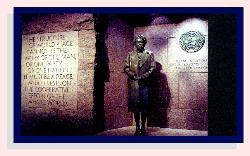 She
was the antipathy of everything a woman was supposed NOT to be in our society. She
was the antipathy of everything a woman was supposed NOT to be in our society.
She was not pretty, in fact many called her homely.
She was almost six feet tall, many called her a scarecrow. Her voice was
high pitched, many called it unpleasant.
She was not demure and retiring, deferring to the
man of her life.
She was the product of her time and class, starting
off life as anti-Semitic and condescending to minorities.
But she grew as a human being throughout her life
and became the most admired woman in the world - and she is arguably ranked
among the top women of the millennium.
Eleanor Roosevelt, born 10-11-1884, was the first
wife of a President of the United States who dared live her own life rather
than existing in her husband's shadow.
Following her husband's death, she became still greater
yet as a U.S. delegate to United Nations who almost single-handedly convinced
UN members to support the Human Rights doctrine.
She is credited with influencing her husband's most
liberal presidential social reforms.
For more than 20 years Eleanor Roosevelt served as
the "eyes, ears and legs" of her husband Franklin Delano Roosevelt
after he was crippled by polio. She campaigning for him for governor of
New York and for the presidency. The she traveled around the nation and
the world personally investigating and reviewing problems as his most trusted
advisor.
She was author, and humanitarian.
She was a woman admired and recognized in almost every
corner of the world - and yet she carried her own bags when she traveled.
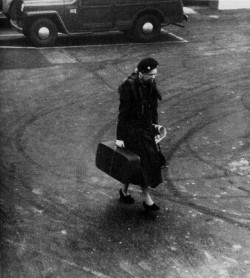 This
is our favorite photo - taken at the Washington airport - that shows her
leaving a cab and carrying her own bag into the terminal. Mind you, this
is a woman born to wealth who had been wife of the President of the United
States longer than any other, was Ambassador to the United Nations, and
the guest, confidant, and friend of every major individual of the world.
Photo from the Roosevelt Library. This
is our favorite photo - taken at the Washington airport - that shows her
leaving a cab and carrying her own bag into the terminal. Mind you, this
is a woman born to wealth who had been wife of the President of the United
States longer than any other, was Ambassador to the United Nations, and
the guest, confidant, and friend of every major individual of the world.
Photo from the Roosevelt Library.
Her participation as his spokesperson in political
campaigns was critical to FDR's election as governor of New York and then
his elections as President of the United States for a record four terms.
In a 1939 Gallup poll, 68% of the American people
approved of her active role in politics.
Her lifelong activism included the National Consumers League, Red Cross,
League of Women Voters, Women's Trade Union League, Daughter of the American
Revolution (which she quit when the DAR forbade black singer Marian Anderson
from performing in their hall), American Student Union, and American Youth
Congress. She was active in the birth control, in the woman's suffrage
movement and dozens of other groups that aided women.
ER chaired the 1961-2 Commission on the Status of
Women and participated in dozens of others causes ranging from fair labor
practices, to activism for Jewish refugees, to black civil rights.
ER's My Day newspaper column reached 4.5 million readers
daily.
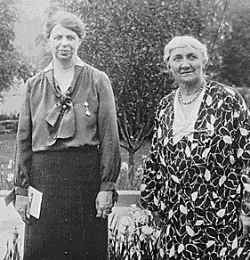 Two
of the most influential women in the history of the world, wife of the
President of the United States Eleanor Roosevelt at the beginning of her
greatest influence and Jane Addams winner of the Nobel Peace Prize who
changed the world through her social activism and the networking of forward-thinking
women. Two
of the most influential women in the history of the world, wife of the
President of the United States Eleanor Roosevelt at the beginning of her
greatest influence and Jane Addams winner of the Nobel Peace Prize who
changed the world through her social activism and the networking of forward-thinking
women.
This photograph has particular significance because
ER was probably elected to receive the 1962 Nobel Peace Prize but died
before the announcement. No Nobel prize is given posthumously so no peace
prize was awarded in 1962.
After President Roosevelt's death in 1945, President
Harry S. Truman appointed Mrs. Roosevelt a delegate to the United Nations
(1945, 1949-52, 1961), where, as chairman of the UN Commission on Human
Rights (1946-51), she played a major role in the drafting and adoption
of the Universal Declaration of Human Rights (1948).
Following its adoption, the UN members gave her a
standing ovation and Truman called her the "the first lady of the
world" although today in hindsight regarding her accomplishments,
it would have been "first citizen of the world."
Photo taken in 1933 and part of the Roosevelt
Library.
ER's personal life was woman-centered. She wrote thousands of love letters
(3,500) to Lorena Hickok, who actually lived with her in the White House.
However, she, apparently, also had close relationships with men other than
her husband.
Following her discovery in the 1918 that her husband was having an affair
with her personal secretary, the Roosevelt marriage appears to become an
impersonal partnership rather than a marriage. FDR, in fact, had numerous
affairs through the years and when he died in Warm Springs, GA, he was
with the widowed Lucy Mercer Rutherford who had come back into his life
after a much earlier affair. The Roosevelt daughter Anna - one of six children
- served as go-between sneaking her into the White House under an assumed
name.
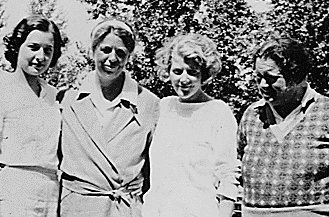 Eleanor
Roosevelt, second from left, is shown with two of her closest friends as
well as Leonora Hickok on the far right at Val-Kill, her hideaway cottage
that was part of the Roosevelt estate at Hyde Park. FDR had given ER the
property as her very own retreat and even constructed a noisy bridge to
warn when people were coming to visit. Eleanor
Roosevelt, second from left, is shown with two of her closest friends as
well as Leonora Hickok on the far right at Val-Kill, her hideaway cottage
that was part of the Roosevelt estate at Hyde Park. FDR had given ER the
property as her very own retreat and even constructed a noisy bridge to
warn when people were coming to visit.
|
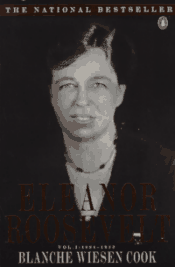 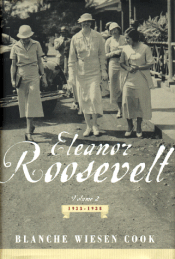 "In
many ways Eleanor Roosevelt remains a bellwether for our belief system.
A woman who insists on her right to self-identity, a woman who creates
herself over and over again, a woman of consummate power and courageous
vision continues to challenge our sense of what is acceptable and what
is possible. To this day, there is no agreement as to who Eleanor Roosevelt
was, what she represented, or how she lived her life. "In
many ways Eleanor Roosevelt remains a bellwether for our belief system.
A woman who insists on her right to self-identity, a woman who creates
herself over and over again, a woman of consummate power and courageous
vision continues to challenge our sense of what is acceptable and what
is possible. To this day, there is no agreement as to who Eleanor Roosevelt
was, what she represented, or how she lived her life.
"Her friends and her detractors have made extravagant
claims of goodness and mercy, foolishness and naivete. She has acquired
sainthood and been consigned to sinner status. Many of us, especially those
of us born daughters in a world that encouraged daughters to sit along
the sidelines of action, are drawn to her because of her vision and her
commitment to an activist's life.
"She continues to haunt our memories and inspire
our days, because she never gave up on life; she never stopped learning
and changing. She worked to transform our world in behalf of greater dignity
and more security for all people, for women and men in equal measure..."
"John Edgar Hoover kept a running
record of Eleanor Roosevelt's every word and activity from 1924 (when she
supported the United States' entrance into the World Court and that 'un-American"
body the League of Nations as well as being active in the first birth control
movement) until her death. Indeed, ER's vast FBI file is one of the wonders
of modern history."
--
Blanche Wiesen Cook in Eleanor Roosevelt, Volume One 1884-1933,
New York: Viking Press. 1992.
The second volume, Eleanor Roosevelt 1933-1938,
New York: Viking Press, 1999 is now available.
MARVELOUS!
The second volume also brings out some unsavory parts of ER. Eleanor
Roosevelt, born to wealth and raised in the cotton batting of Anglo-Saxon
superiority was ORIGINALLY not race conscious, in fact used terms like
"darkies" and uttered various slurs about Jews. Blanche Wiesen
Cook said she wrote part of the second volume "curled in agony. I
didn't want to finish the book."
As the product of wealth and privilege both ER and
her husband carried the prejudices of their class and the times. But both
changed - both developed. ER first. Perhaps the place of Lorena Hickok
in herstory is not whether or not she was a sexual partner of ER's but
how she broadened ER's perspectives and awakened the compassion that made
ER the most admired woman in the world.
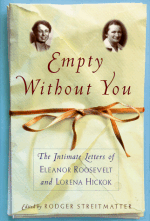 If
you want to decide for yourself what the relationship between ER and Hick
was, read Without You: The Intimate Letters of Eleanor Roosevelt and
Lorena Hickok (collected) by Rodger Streitmatter. New York, 1998: Free
Press. It presents only 300 of the 3,500 letters ER wrote to Hick but it
is said to be a fair representation. However, his claim that his volume
presents the "first" public view of the letters is false. If
you want to decide for yourself what the relationship between ER and Hick
was, read Without You: The Intimate Letters of Eleanor Roosevelt and
Lorena Hickok (collected) by Rodger Streitmatter. New York, 1998: Free
Press. It presents only 300 of the 3,500 letters ER wrote to Hick but it
is said to be a fair representation. However, his claim that his volume
presents the "first" public view of the letters is false.
Doris Faber's The Life of Lorena Hickok, ER's Friend is also
recommended although Faber is obviously in a state of shock. Faber is the
one who discovered the ER letters to Hickok that had been stuck away in
a box with state papers, etc. It was the first public awareness of ER's
secret inner life. It also contains a very good biography of Hickok who,
after all, was a highly honored and one of the highest paid news reporters
of the day.
ER's autobiographies are This Is My Story (1937) and On My
Own (1958).
Recommended biographies include Eleanor and Franklin (1971);
Eleanor: The Years Alone (1972) by Joseph P. Lasch; Eleanor Roosevelt:
First Lady of American Liberalism (1987) by Lois Scharf. The Lasch
books are "accepted" types of biographies, depending on the public
persona; good for dates and facts.
ER was so complex and so much of her hidden from our view that no one
author has been able to fully portray her.
One revealing remark by Blanche Wiesen Cook in an
interview perhaps sums ER up the best: "What
impressed me most in my research," said Blanche Wiesent Cook,
"is how far she came ...Some of her early letters
to her mother reflect that she was a casual anti-Semite and bigot ...She
could have lived the comfortable, cloistered life.
"But she experienced suffering early on. Her
father drank himself to death at age 32 and her mother gave up and died
at age 29. Eleanor could've retreated and no one would blame her. But she
turned that into compassion, first for her family and those she loved and
then into compassion for the whole world."
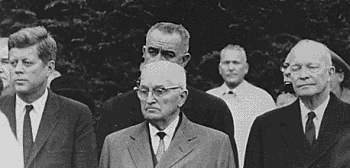 Four
presidents mourn at the funeral of Eleanor Roosevelt, from left, John F.
Kennedy, Harry Truman, and Dwight Eisenhower. Just in view behind Truman
is then vice-president Lyndon Johnson who would become president following
Kennedy's assassination. Four
presidents mourn at the funeral of Eleanor Roosevelt, from left, John F.
Kennedy, Harry Truman, and Dwight Eisenhower. Just in view behind Truman
is then vice-president Lyndon Johnson who would become president following
Kennedy's assassination. |
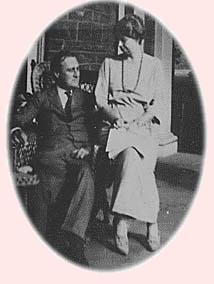
| PRIOR DATE |
| HOME |
| WOA INDEX |
| NEXT DATE |
| RETURN TO TOP OF PAGE
|
Toscano
Excommunicated for Speaking Out of God the Mother
Margaret Merrill Toscano, a Utah Mormon feminist,
was honored by the Utah NOW in 1993 for her courage for lecturing on the
goddess tradition and the role of God the Mother within the Latter Day
Saints (Mormon) theological framework despite threats of church disciplinary
action. She was excommunicated. This is an excerpt from that moving speech.
The full text is posted in the WOAH library:
"I could not expect to be a member in good
standing when I had spoken out on issues which he said were embarrassing
to the Church, on issues such as women's right to the priesthood and the
importance of female deity.
"I told him that I could not be silent, and not
simply because I feel strongly that women will always be second-class citizens
in the Church so long as they are denied priesthood and God is spoken of
only in male terms.
"More important for me was the issue of silence
itself. More fundamental was the question of freedom of conscience and
speech. I could not and would not be silent because to do so would reinforce
what I see as the major problem in the LDS Church today: an oppressive
and legalistic authoritarianism which is not only contrary to the basic
tenets of Mormonism but which also destroys the climate of freedom and
grace that is necessary for individual growth and the flourishing of an
open-minded and loving religious community."
| PRIOR DATE |
| HOME |
| WOA INDEX |
| NEXT DATE |
| RETURN TO TOP OF PAGE
|
London
Bridge is Falling Down
"London Bridge is falling down, falling down,
falling down,
"London Bridge is falling down, my fair lady."
The hidden meaning of this cute little ditty popular
with children for hundreds of years has been obscured through the passage
of time. The "my fair lady" doesn't refer to a Broadway musical
but to the bones of a virgin girl. It was customary to bury a dead virgin
(sometimes killed for the occasion ) in the foundation of bridges and buildings
as well as the walls to keep them upright. It's all part of the virgin
cult that appears in every patriarchal culture a female virgin has supernatural
powers that are beneficial to a man or a community at her death. (Obviously
NOT beneficial to the women involved.)
| PRIOR DATE |
| HOME |
| WOA INDEX |
| NEXT DATE |
| RETURN TO TOP OF PAGE
|
10-11 DATES, ANNIVERSARIES, and
EVENTS
B. 10-11-1758, Anna Warner Bailey - U.S. hero. AWB was a the
favorite "feminine" woman heroine of the American revolutionary
war who was lauded in story and song from tavern to every place men gathered.
According to legend/history, she searched a battlefield
for her uncle in 1781, found him dying, rushed home to get her aunt and
baby and transported them to the side of the dying man. As Mother Baily,
she is also to have donated her petticoat as wadding for cartridges in
the War of 1812.
B. 10-11-1871, Harriet Ann Boyd Hawes - U.S. archaeologist. HABH
gained world renown by being the first archaeologist to discover and completely
evacuate a Minoation site that dated from the early Bronze age. During
1897 she was a volunteer nurse during the Greco-Turkish war and again during
the Spanish American war. During World War I she nursed Serbian soldiers
at Corfu and later organized and led a Smith College Relief Unit to France.
B. 10-11-1891, Rose Peabody Parsons - president (U.S.) National Council
of Women 1956-59.
B. 10-11-1902, Frances Lillian Ilg - U.S. pediatrician, educator,
and co-founder and director of the Gesell Institute of Child Development.
She co-authored more than 20 books with either Dr. Arnold Gesell or Dr.
Louise Ames Ph.D. She also wrote a newspaper column on Child Behavior with
Dr. Ames who was .an officer with the institute.
B. 10-11-1905, Jane Sherwood - U.S. radio star of the very popular
radio show of the 1930s and 40s, Easy Aces.
B. 10-11-1939, Maria Bueno - Brazilian tennis player who was
one of the world's top seeds from 1958 to 1968. She won three Wimbledons
(1959, 1960, 1964) and four U.S. singles (1959, 1964, 65, 66). MB also
won 12 grand Slam doubles. Her remarkable performance was even more astounding
when one realizes she suffered from hepatitis 1961 to 1963. She was voted
the Associated Press Female Athlete for 1959.
B. 10-11-1950, Patty Murray - U.S. Senator from Washington State.
Elected in 1992 and reelected in 1998, both times as an underdog (according
to the media).
PM ran for elective office after being told that she
was a nobody, "just a mom in tennis shoes" when she attempted
to lobby state government. Her first office was with the state legislature
during which she campaigned in tennis shoes.
An amazing coalition builder, she then took on the
favorite, very rich Republican for the Senate and beat him in spite of
a small campaign budget. It wasn't much different in 1998 and again she
beat the money overwhelmingly. The media consistently underestimates her
popularity and effectiveness because they deal primarily in "king
of the hill" type stories for headlines while the patient, coalition
type building of commitment by commitment is ignored as "unexciting."
A feminist, she fought for the Family and Medical
Leave Act and other bills that aided women's financial positions.
She hasn't tried for a national platform, staying
regional and emphasizing service to her constituents, to her state - and
to women.
Event 10-11-1963: After almost two years of work, the final report
of the President's Commission on the Status of American Women, is presented
to President Kennedy and on 11-01-1963, Kennedy creates a Citizen's Advisory
Council on the Status of Women. Although its executive secretary is Catherine
East, the advisory council's membership will be primarily men. Pres. Kennedy
was NOT a supporter of women's rights.
Event 10-11-1987: more than 200,000 lesbians, gays, and supporters
rally in Washington for more Federal money to combat AIDS.
Event 10-11-1991, Anita Hill testifies before Senate Judiciary
Committee charging Supreme Court nominee Clarence Thomas with sexually
harassing her. The way AH was questioned on TV roused the resentment of
women nationwide and probably caused one of the most important political
changes in decades. Angry women went to the polls the next election in
record numbers and for the first time in U.S. history, women's votes carried
elections.
There was not a single woman on the U.S. Senate judiciary
committee that questioned AH. Women resented not only the way she was questioned,
but also that questions that were obvious to a woman's view were never
voiced.
For example, when AH was accused of reading a book
that contained a certain phrase about hair, was it not possible that Clarence
Thomas who was known a devotee of pornography (as brought out in an earlier
judicial hearing) had read that book and did actually quote the phrase?
Why wasn't he asked?
Anita Hill said one year later:
"I regret in many ways that it [my testimony]
was manipulated or misperceived. And I have my moments when I just wish
that I could go back to the way things were before. But that's not realistic.
"When I think of what has happened in a larger
sense, beyond myself, then I would not change anything." "I am
really proud to be a part in whatever way of women becoming active in the
political scene.
"I think it was the first time that people came
to terms with the reality of what it meant to have a Senate made up of
98 men and 2 women."
| PRIOR DATE |
| HOME |
| WOA INDEX |
| NEXT DATE |
| RETURN TO TOP OF PAGE
|
QUOTES DU JOUR SALUTING ELEANOR ROOSEVELT
LUCE, CLAIRE BOOTH
"No woman has
ever so comforted the distressed or so distressed the comfortable."
STEVENSON, ADLAI
"She would rather
light candles than curse the darkness and her glow has warmed the world."
(This now appears in Bartlett's.)
At her memorial service, Stevenson asked, "What
other single human being, has touched and transformed the existence of
so many?" Born of wealth and privilege, ER walked "in the slums
. . . of the world, not on a tour of inspection . . . but as one who could
not feel contentment when others were hungry."
SCHLESINGER, ARTHUR
"Her liberation
was not an uncovenanted gift. She attained it only through a terrifying
exertion of self- discipline.... If her mastery of herself was never complete,
if to the end of her life she could still succumb to private melancholy
while calmly meeting public obligation, this makes her achievement and
character all the more formidable."
-- Above quote from the forward
to Joseph P. Lash's Eleanor and Franklin.
FELDER, DEBORAH G.
"Historians and columnists have called
Eleanor Roosevelt 'the most liberated American woman of this century' and
'the most influential woman of our times.' To her husband, Franklin Delano
Roosevelt, she was 'the most extraordinarily interesting woman' he had
ever known. She did not claim to be a feminist, yet she was the personification
of the strong, independent, liberated woman. She used her influence as
first lady and private citizen to advance the cause of human rights, and
in doing so, became the conscience of the country and the most important
public woman of the twentieth century.
--Felder, Deborah G. The 100
Most Influential Women of All Time. New York: Citadel Press, 1996.
|
ER's statue on Riverside Drive, New York City. Stop by,
she's still listening.
|
| PRIOR DATE |
| HOME |
| WOA INDEX |
| NEXT DATE |
| RETURN TO TOP OF PAGE
|
|

